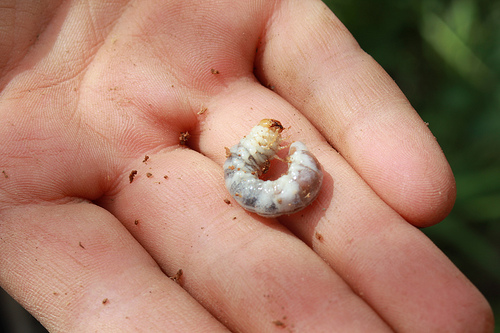50% Off First Application¹
Call 1-855-940-1479
and connect with a TruGreen consultant
5 Lawn Bugs that are Destroying Your Yard
There are a lot of lawn bugs that can cause damage to your lawn. By educating yourself on the types of bugs that are a threat to your area, you can prevent them from becoming a problem in your yard. Here are 5 of the lawn bugs that are most likely to cause harm to your grass:
Chinch bugs
Scientific name: Blissus leucopterus
Chinch bugs find their way into lawns during dry periods. Once your lawn has been invaded by this pest you’ll start to notice yellow or bare patches throughout your grass. These bugs are very small, usually no longer than 4 millimeters in their adult state. In color they range from bright red to a darker shade that’s nearly brown in appearance. When a large amount of chinch bugs is present, they can sometimes be identified by their pungent smell – especially if crushed (much like stink bugs).
The best way to get rid of this problem bug is to thoroughly irrigate your lawn. Chinch bugs are a symptom of a dry lawn, so their presence usually indicates that you haven’t been watering as frequently as you should. Water your lawn frequently, enough to keep the soil moist, for a month or less. By this time the bugs should have evacuated your lawn and you can reduce watering to the normally recommended amount.
White grubs
Scientific name: Cyclocephala
Grubs are the larval form of May, Japanese, or June beetles. They range from 20 to 45 millimeters in length and are have a curved white body and a brown head. These pests cause the most damage in their adult form, but the larvae are capable of wreaking havoc in your lawn as well. The life cycle of these bugs can range anywhere from one to three years.
When white grubs invade your lawn, they cause damage to the roots of your grass. You are most likely to notice the signs of their presence in spring or fall. If moles become a problem in your lawn, it could be because of the presence of grubs. White grubs can be eliminated by allowing your lawn to remain dry for several weeks, but doing so could have its own negative effects. The best way to put an end to these pests is to use chemical control methods.

Sod webworms
Scientific name: Fissicrambus mutabilis, Parapediasia teterrella, Pediasia trisecta
There are many varieties of sod webworms that could find their way into your lawn. Bugs like webworms are usually present because of a lack of proper irrigation in your yard. In larva state these pests are about 19 millimeters in length, and in their adult form they can grow to be as long as six millimeters longer.
In their larval state they are similar to a caterpillar, and they eat away at grass for their entire time in this form. This can cause quite a big dent in the grass in your lawn, especially if many of these pests are present. Like caterpillars, they then enter a pupa state and eventually emerge as a moth. Sod webworms are sometimes referred to as lawn moths.
Mole crickets
Scientific name: Gryllotalpidae
Mole crickets are a very common lawn threat, especially in warm or coastal areas. These common lawn bugs range in size from 30 to 50 millimeters and are cylindrical in shape. Their arms are shovel-like, which comes in handy when they start causing problems by burrowing through your lawn.
Once they begin burrowing in your lawn they cause the soil to swell up. Their tunnels can be spotted as raised tubes in your lawn. Bugs like these can also cause other eyesores like brown patches. They are most active in late summer and early fall.
Mites
Scientific name: Bryobia praetiosa, Petrobia late, Oligonychus pratensis
Mites are very small, sometimes even microscopic. Many types of mites are active in lawns across the United States. Some of the most common include clover mites, brown wheat mites, and Banks grass mites. The most significant damage caused by mites takes place in early or mid-spring. Like many other pests mites can be prevented with proper lawn care, especially irrigation. Dry yards welcome all sorts of pests, by keeping your lawn healthy it has the best shot at fighting off these intruders.

TruGreen will gladly visit your property as often as needed between scheduled visits to make any necessary adjustments and to ensure your satisfaction.
Getting Started with TruGreen
- Call or fill out the form above to reach a lawn care specialist.
- Know the square footage of your yard, as well as any specific areas of concern.
- With the help of your specialist, create a customized lawn care plan that meets your lawn’s needs.
- Schedule your Healthy Lawn Analysis2 to start your service.
